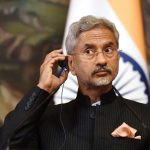There is something quite unique about China’s Covid data. In the midst of a severe rise in infections due to the rollback of the ill-conceived “zero Covid” policy, China’s infections per million population barely reflect a bump. In fact, the infection rate in Australia at 641 and Japan at 1,264 (per million as of December 22) is far worse than China’s 1.86 (see graph).
This is remarkable but hardly surprising. Through much of the Pandemic, China’s infection graph (data sourced from ourworldindata) has been almost a flat line showing very few infections on a seven-day rolling average, unlike any other country in the world. The Covid graph of most countries shows a variation of ups and downs as the infection surged and waned with smaller troughs in between. Not so for China. It was almost as if someone drew a line that health agencies reporting cases could not violate. Zero Covid became a zero sum game: questioning it was akin to questioning the Chinese communist party’s wisdom.
This sanguine picture of the Covid situation in China is completely at odds with anecdotal accounts from private citizens and reports from the few journalists still stationed in Beijing. If proof were required the despairing cry from a hospital in Shanghai says it all: “In this tragic battle, the entire Greater Shanghai will fall, and we will infect all the staff of the hospital! We will infect the whole family! Our patients will all be infected! We have no choice, and we cannot escape”
Not unexpectedly, the post vanished from WeChat soon after it was posted on Thursday. The truth is that no one will ever know how many infections and deaths have occurred. Not the least because China has altered the manner in which deaths are to be reported as only those who die due to respiratory causes will be registered as Covid casualties. Estimates are that cities will report cases in millions even as the official death count is a blank – a cruel and ironic play on “Zero Covid”.
There is a view that the Chinese new year is approaching and the peak may happen in a month or two. This might finally mean that the wider immunity against the infection – lacking due to harsh lockdowns – may become prevalent. This will hopefully lead to a plateauing of infections. Reports indicate that the infections caused most probably by Omicron variants are resulting in much more severe symptoms in China than elsewhere. This seems to be due to vaccines like Sinovac having just about 50% efficacy required to meet WHO standards and lack of widespread natural immunity.
All this raises more serious questions for President Xi Jinping and the communist party as a whole. Though the public protests against Zero Covid were unprecedented, they are unlikely to herald any sustained popular uprising. The CCP has mastered many ways of controlling dissent and it would be fair to say that there is no mass mobilization either. But the deeply embarrassing Covid policy rollback and the current stress in the economy hurt a basic principle of the CCP – one which Xi fully adheres to – that the legitimacy of the party and its supreme role in guiding the affairs of China must remain inviolate. Even Xi’s crackdown on big tech, despite the elements of personal agenda, can be explained on the grounds that some of these firms and gurus like Jack Ma had begun to feel that they were above the law. In China no one is bigger than the CCP. Despite the exile that Xi and his family were subjected to during the Mao era, the leader is deeply committed to ensuring and safeguarding the primacy of the communist party. Everything is subservient to this cause.
The dogmatism and lack of genuine feedback that are hallmarks of autocratic regimes prevented Xi and other leaders from accepting that Zero Covid was not only not working but was in fact counter-productive. It was scarring the economy and generating public disaffection as major cities remained under frequent lockdowns that sometimes stretched as long as 70-80 days. A sense of superiority that envelops Chinese decision makers and the claim that the communist system is better than democracies has taken a hit. There is no getting away that China’s Covid policy despites successes like setting up large hospitals in weeks after the outbreak has not been the triumph it was touted to be as recently at the party Congress which crowned Xi as supreme leader for a third term.
The misfiring economy is even more worrisome. Again, while predictions of a hard landing are not likely to come to pass, the larger question is one of the legitimacy and credibility of the party system and Xi’s leadership. The long held compact between the party and citizens has been that while there will be no popular democracy, there will be a clear improvement in quality of life and living standards. For decades since the era of Deng Xiaoping the party has indeed delivered on these counts, providing a good quality of education and health care and lifting hundreds of millions out of poverty. A growing middle class enjoyed western style urban lifestyles and international travel while China developed a powerful military and earned laurels at the Olympics — all of which justifiably swelled national pride.
Along with China’s rise, its leaders and certainly Xi since he took charge in 2014, proclaimed the inevitability of the nation’s ascendancy as a paramount power first in Asia and then across the world as the US declined and the communist giant woke to its manifest destiny. This narrative is not likely to be dented much right now and most Chinese will believe that their nation will or should get its due denied by an envious west. But developments since Covid have introduced troubling strands not easily explained away about the wisdom and choices of the party and its leaders. After all, democracies like India were held in disdain for being noisy and chaotic, unable to act in a disciplined manner to fulfill their potential let alone challenge China. Now it transpires that the Chinese leadership has fluffed its lines on major national tasks like containing Covid and cushioning the economy from the pain inflicted by the pandemic and the Russian war on Ukraine. Some time before the October party Congress, Xi declared that China has achieved the first centenary goal of becoming a “moderately prosperous” country. At the Congress itself, he said the nation must be a modern socialist power by 2035 and achieve the target of being a world leader in composite national strength by 2049. These ambitious objectives have not been shelved nor can it be said that China lacks the wherewithal to achieve them. But the poor decisions of the Chinese leadership that inflicted avoidable hardship on millions of people are a shoddy advertisement for the central government’s capacity to chart course for the future.
It cannot but be obvious to the numerous Chinese who live outside the mainland that the mood towards their country has soured in the past few years. Less than a decade ago, Chinese students on foreign campuses were a given and universities in the US, Canada and Australia sought them out. China’s rivalries and frictions with neighbours like the Asean countries and India were unresolved but did not intrude into the wider consciousness. Under Xi, China has increasingly adopted a take-it-or-leave-it policy that has rubbed many the wrong ways. The calculation that China is now too big to stop might have been premature. For many Chinese elites, certainly those in the party-government system, it was difficult to understand why others were unwilling to accept the obvious logic and validity to Chinese hegemony. Events since the outbreak of Covid might have injected an element of doubt. To begin with, as in the case of SARS, China hid the emergence of serious pneumonia like infections in Wuhan, allowing infected persons to travel abroad. Then it refused to allow a transparent investigation into the cause of the outbreak. Not just that, it turned belligerent towards nations like Lithuania, South Korea and Australia who dared to ask inconvenient questions. It became prickly and defensive when formations like QUAD and AUKUS sought to shore up supply lines and bolster security in the Indo-Pacific. It picked up brawls with India on the line of control within months of Covid’s emergence in early 2020 and barely halted its illegal activities on disputed islands in the east and south China seas. All in all, it must be clear to Chinese expats that their nation was being seen as an aggressive and malevolent power.
The real estate slowdown in China has been widely reported as consumers stopped paying mortgages in view of builders being unable to complete projects. Revenues from land and construction are an important source of funding for regional and local governments in China. In some cases land parcels have been repeatedly re-mortgaged and as long as the wheel was turning the various governments kept themselves afloat. China needs to address this problem expeditiously to make certain that a basic compact to provide or facilitate housing for the people is not reneged upon. Over the years, the Chinese government developed less intrusive methods of keeping tabs on the country. By largely eschewing more in-your-face methods, China’s urban citizens could get on with their lives without necessarily interacting with the party on a regular basis. Of course, the controls that lay beneath the surface were clearly recognizable as Leninist-Marxist devices. Xi has reversed some of this and made restrictions more palpable. In November, China announced a package to rescue the real estate sector by easing lending and allowing banks to extend mortgages. There was a rise in the prices of property stocks. Zero Covid had squeezed manufacturing and spending and consumer spending. The irony is that while the oppressive policy has been reversed, a new wave of infections might place fresh strains on state capacity and the economy.
/wp-content/uploads/2022/12/Covid-China.jpg)

/wp-content/uploads/2025/05/Cover-War-Shock-1.jpg)












More Columns
On Being Young Surya San
Why Are Children Still Dying of Rabies in India? V Shoba
India holds the upper hand as hostilities with Pakistan end Rajeev Deshpande